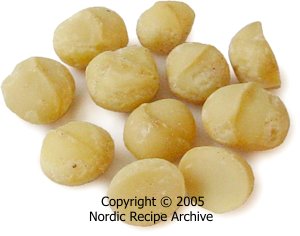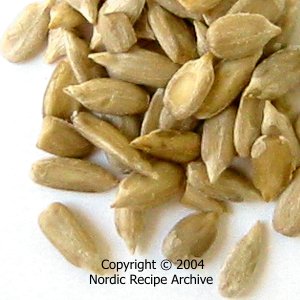|
|
|
NUTS AND SEEDS
|
Listed below are some nuts and seeds mostly used in Finnish cooking and in the recipes of this site.
 Because of their high fat content, various nuts and seeds turn rancid quickly. Always use as fresh nuts and seeds as possible and taste them, if necessary, before using in cooking — except nutmeg, which is toxic if consumed in large quantities.
Because of their high fat content, various nuts and seeds turn rancid quickly. Always use as fresh nuts and seeds as possible and taste them, if necessary, before using in cooking — except nutmeg, which is toxic if consumed in large quantities.
Even just slightly rancid nuts or seeds will spoil the taste of any dish. Buy unshelled nuts whenever possible, they will keep longer than shelled nuts.
See also:
|
|

Hazelnut
(Corylus avellana)

Fruit of the hazel tree, the hazelnut is mainly used in pâtisserie and confectionery to flavour cakes, pastries, breads, sweets, creams, chocolates, nougat, praline paste, liqueurs, etc.
It is also used in many savoury dishes like salads, stuffings, meat or vegetable terrines, etc. Hazelnut oil is used to flavour foods, bread doughs and salad dressings.
There are several varieties of hazelnuts. Filbert is a cultivated hazelnut which is slightly larger than other varieties.
|

|

Walnut
(Juglans regia)

Fruit of the walnut tree, the walnut is used much in the same way as the hazelnut (see left). It can be added to salads, sauces, terrines, breads, cheeses, cakes, pastries, confections, liqueurs, etc.
Walnut oil is used to flavour foods, bread doughs and salad dressings.
|
|
Almond
(Prunus dulcis)

Sweet almond (Prunus dulcis var. dulcis), the fruit of the almond tree, is widely used in cooking, both in savoury and sweet dishes, or simply eaten plain, or roasted and salted, as snack.
Aromatic almond oil is obtained from the strong tasting bitter almond (Prunus dulcis var. amara). Bitter almond contains some toxic substances, like hydrocyanic acid, which is poisonous in large amounts. The almonds and their oil are used in small quantities to flavour desserts, pâtisserie and beverages.
|
Pistachio
(Pistacia vera)

Pistachio is the greenish kernel, or fruit, of the pistachio tree. Like almonds (see left), pistachios are used in many sweet and savoury dishes and preparations, and as garnish for cakes and pastries.
They are also eaten plain, or roasted and salted, as snack.
|
|
Pecan nut
(Carya illinoensis)

The pecan nut is the fruit of the pecan tree, native to North America.
The buttery rich and delicate flavour of pecan nut resembles the walnut and is used much in the same way, both in savoury and sweet dishes or just eaten plain.
|
Cashew nut
(Anacardium occidentale)

Cashew nut is the fruit of the cashew tree, native to South America. The tree produces fruit-like swellings, resembling pears or apples. Each of these swellings produces a cashew nut, hanging below them.
Cashew nut is eaten as snack or added to salads, curries, sauces or vegetable and meat dishes.
|
|
Peanut
(Arachis hypogaea)

Peanuts, also called groundnuts, grow in underground pods, each containing two to three seeds.
Peanuts may be eaten roasted and salted or used in many sweet and savoury dishes, sauces, nut butters and pastes.
Peanut oil is especially suitable for deep-frying, since it withstands high temperatures better than some other vegetable oils.
|
Brazil nut
(Bertholletia excelsa)

Flavour of the Brazil nut, the fruit of the Brazil-nut tree, resembles that of coconut.
Besides being served as snack or candy, Brazil nuts can be added to cakes, salads and ice creams. They can be used instead of coconuts in some recipes.
|
|
Macadamia nut
(Arachis hypogaea)

Macadamia nut, also called Queensland nut, is the fruit of the macadamia tree, believed to be native to Australia.
Macadamia nuts have a sweet flavour, reminiscent of Brazil nut or coconut. They are used to flavour curries, stews and salads, or used in desserts, pâtisserie and ice creams. They are also eaten plain or roasted, or as candy, covered in honey, chocolate, etc.
|
Nutmeg
(Myristica fragrans)

Nutmeg is the hard seed of the nutmeg tree, used in small quantities as a seasoning.
Read more about nutmeg here.
|
|
Coconut
(Cocos nucifera)

Coconut is the fruit of the coconut palm, growing in most tropical countries.
Fresh coconut has a thick, usually greenish husk enclosing the thin and hard, brown shell. Inside
the shell, lining the central cavity, is the white and firm pulp. The cavity is
filled with coconut water. As the coconut matures, the amount of water will decrease.
Coconut water may be served as a refreshing drink. The fresh or dried pulp is used to flavour both savoury and sweet dishes, or made into coconut milk or cream.
Dried coconut meat, called copra, is processed into coconut oil or butter. In domestic use in Finland, coconut butter is used mainly for deep-frying and in candy-making.
In picture below: fresh green coconuts.

|
Chestnut
(Castanea sativa)

The fruit of the sweet chestnut tree, with its sweet and nutty flavour, is suitable to be used in a number of savoury and sweet dishes.
Chestnuts can be baked, cooked, steamed or roasted whole. They are used in soups and stuffings or ground into chestnut flour. Whole cooked chestnuts are served to accompany various meat and game dishes or vegetables like boiled Brussels sprouts.
Sweetened chestnut puree, candied chestnuts and chestnuts preserved in syrup are used in cakes, desserts and sweets.
Good quality chestnuts feel heavy and firm and have shiny, dark brown shells. Soft, light chestnuts are past their prime.
|
|
Pine kernel
(Pinus pinea)

Pine kernels, also called pine seeds, pine nuts or pignoli, are harvested, often by hand, from the
large-sized cones of various pine trees. The small kernels have a delicate, nutty flavour, resembling that of almond. Some varieties may have a slightly resinous taste
which is neutralized if the kernels are roasted.
Like nuts, pine kernels are used to flavour or garnish various sweet and savoury dishes, like meat, fish, vegetable and rice dishes, sauces, salads, desserts,
cakes and cookies. They are an important ingredient in Italian pesto sauce.
|
Sunflower seed
(Helianthus annuus)

The sunflower, native to Mexico and Peru, was introduced to Europe at the turn of the 15th and 16th centuries (see the picture below).
Sunflower seeds are used to produce oil, and like other seeds and nuts,
they may be added to numerous savoury and sweet dishes and sprinkled on salads. They are also eaten fresh or roasted and salted as a snack. The seeds have a mild, nutty flavour.
They may be sprouted to grow nutritious sunflower shoots.

|
|
Sesame seed
(Sesamum indicum)

Seeds of the sesame plant, the sesame seeds, are eaten plain or roasted. They are added to many savoury dishes and sauces, used as condiment and garnish for breads and pâtisserie or ground into sesame paste (tahini).
Many oriental candies and sweetmeats, like halva, are made with sesame seeds.
Sesame seeds are also used to produce sesame oil. Depending on the variety, the colour of the seeds may vary from white and yellow to reddish and black.
|
Poppy seed
(Papaver somniferum)

Ripe poppy seeds are gathered from the seed capsules produced by the flower of the opium poppy (see the picture below). The slate blue seeds are very small in size and have a subtle, nutty flavour.
Poppy seeds are used to flavour and garnish breads, cakes, cookies and other pastry items. They are also added to savoury dishes, dressings, spice blends and desserts and used to produce poppy oil.

The drug opium is prepared from the dried latex gathered from the unripe poppy capsules. Although coming from the same plant as opium, the poppy seeds and oil are not narcotic, because they develop after the capsules have lost the opium-yielding potential.
|
|
Pumpkin seed
(Cucurbita pepo)

Pumpkin seeds — also known as pepitas — are collected from the inner cavity of pumpkin fruits.
The seeds can be slowly roasted and eaten as snack, salted or flavoured with many other spices.
The seeds have a sweetish, nutty flavour and a slightly chewy texture. They can be added to salads, bread doughs, muesli mixes, porridges and other foods, or
used as a garnish sprinkled on breads, buns and other pastry items. The seeds are also pressed to obtain pumpkin seed oil used in salads, cooking, etc.
Depending on the variety, pumpkin seeds may either be enclosed in a tough seed coat (see the picture below) or grow without a shell, which makes them easier to work with.

|
Flaxseed
(Linum usitatissimum)

Also called linseeds, flaxseeds are extracted from flax plant, the fibre of which is used to produce linen fabric.
Linseed/flaxseed oil pressed form the seeds is used both in cooking and industry. The seeds — whole, crushed, ground, soaked or roasted — may be added to porridges, bread doughs, muesli mixes, etc, into which they lend a nutty flavour.
Several health-promoting aspects — like protection from heart disease and certain cancers and promotion of gastrointestinal functions — have been related to consuming of flaxseed, being particularly high in omega-3 fatty acid and fibre.
However, flaxseeds also contain small amounts of potentially toxic substances like cyanogenic compounds and cadmium, and should be consumed in small quantities only, following official dietary guidelines. Children weighing under 15 kilograms and pregnant women are recommended to avoid consuming flaxseeds altogether.
|
|
|

